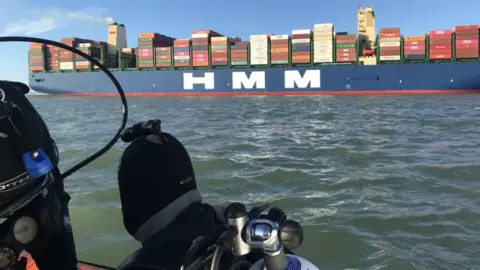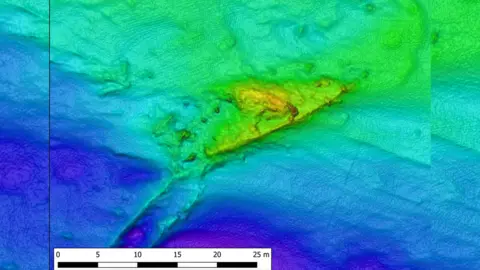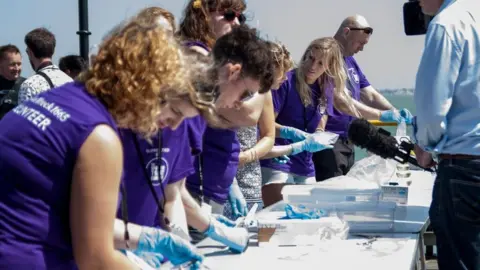The London: Seabed images from Southend 'reveal shipwreck erosion'
 Carol Ellis
Carol EllisNew seabed images provide scientific evidence an "at risk" 17th Century shipwreck is "rapidly deteriorating", says a diver who wants it saved.
The London sank in the Thames estuary in 1665 with the loss of 300 lives.
Historic England commissioned the shipwreck survey. It will be compared to 2016 images to assess its condition.
Steve Ellis said he had seen heavy shipping wash away the battleship's protective mud during a decade of diving.
 National Maritime Museum, London
National Maritime Museum, London"I'm always seeing things be uncovered after a ship goes by and the next time I dive, they have gone," the licensed diver from Leigh-on-Sea in Essex said.
"Just a couple of weeks ago I spotted a complete leather shoe.
"The scans confirm what I keep saying - the site is rapidly deteriorating."
The London was its way to fight in the Second Anglo-Dutch War (1665-67), when it blew up off Southend-on-Sea.
 Spectrum/MSDS Marine
Spectrum/MSDS Marine Spectrum/MSDS Marine
Spectrum/MSDS MarineThe wreck, which is on Historic England's At Risk Register, was covered by mud until the development of the Thames Gateway port which meant bigger ships sailing on the estuary.
Mr Ellis has already helped bring up hundreds of artefacts, including instruments, gun carriages and a compass.
However, every time he spots something, he has to then seek permission from Historic England each time before he can salvage it, and often objects have disappeared when he dives back down to get them.
 Steve Ellis
Steve Ellis Historic England
Historic EnglandThe Save The London Campaign was set up a year ago by the Nautical Archaeology Society to raise funds to save the wreck.
Its chief executive Mark Beattie-Edwards said their "dream" was for the ship and its artefacts to be housed in a permanent museum in Southend.
He said the new survey provided "empirical evidence the threat to the site has only got worse".
Historic England's maritime archaeologist Hefin Meara said: "Information given to us by Steve Ellis is that the propellers of the big heavy shipping are having an adverse effect.
"We can now compare the recent survey with the 2016 survey to quantify this - and see if this gives us a strong case to go forward."

Find BBC News: East of England on Facebook, Instagram and Twitter. If you have a story suggestion email [email protected]
